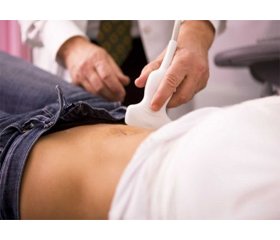Международный эндокринологический журнал 2 (66) 2015
Вернуться к номеру
Diagnostics and treatment of syndrome of polycystic ovaries in children’s gynaecology
Авторы: М.U.Sergienko, E.B.Yarovleva, D.M. Mironenko - Regional center of maternity and child protection, Donetsk, Ukraine
Рубрики: Эндокринология
Разделы: Справочник специалиста
Версия для печати
syndrome of polycystic ovaries, children’s gynaecology
There’s such an opinion that the syndrome of polycystic ovaries (SPCO) is a terminal stage of chronic anovulation; the chains of this development can be disorders of the secretion rhythm of gonadotrophic releasing hormone (GnRH) and gonadotropins, especially of luteinizing hormone (LH), hyperandrogenia (HA), insulinresistance (IR) and hyperinsulinemia, disorder of lipid metabolism, hyperprolaktynemia. And it’s just impossible to find out which of the enumerated factors could be the primary one.
According to consensus of European society of reproduction and embryology and American society of reproductive medicine 2012, forty five (45) percent of women of reproductive age with SPCO suffer from barrenness; sixty five (65) percent of endocrine barrenness falls to the share of SPCO. Close association of syndrome with metabolic disorders involves the development of such complications as obesity; it increases the risk of second-type diabetes ten times, seven times the risk of arterial hypertension and ischemic heart disease, including myocardial infarction; more than two times — the risk of oncological disease of ovaries, endometria of mammary glands [6].
Formation and manifestation of clinical display of syndrome often starts from teenage years.
The aim of the research was the study of diagnostics and treatment of SPCO in children gynaecologist according to information from medical literature and one’s own research.
The diagnostics of SPCO in teenage years still raises many questions. The problem is that the characteristic of normal sexual development often coincide with symptoms of SPCO, therefore a number of researchers suggest that a high level of demand should be applied to establishing of the diagnosis. Thus Sultan and Pars consider it necessary the four out of five criteria to be present: oligo- or amenorrhea for two years after menarche, clinical HA, laboratory HA, insulinresistance or hyperinsulinemia, polycystic transformation of ovaries on ultrasound examination. According to last consensus ESHRE/ASRM, it is permitted to hold to Rotterdam criteria; however, in order to establish the final diagnosis in teenage years, all the three criteria must be present. Some other researchers admit that in the cases when there were exposed only two out of three criteria at the girls, it was quite possible to establish the SPCO diagnosis with the aim of more thorough observation of these patients [9].
We approach cautiously to the establishment of final diagnosis of SPCO taking into account its interpretation as a global problem of somatic health — endocrine-metabolic state, cardiovascular and oncogenetic risk. Besides, one of the main ways of the therapy of SPCO is receiving COC, which are unwelcome the young girls to be prescribed in the case of oligo- and amenorrhea without thorough examination and the use of all possibilities of vitamin-, phytotherapy and gestagens.
Conclusions. Thus, because of the use of achievements of scientific knowledge and modern method of diagnosis, it is possible to suspect in teenage years development of SPCO, in some cases — prevent its further development. It’s obvious that timely and adequate treatment of HA and anovulation at young patients with SPCO completes not only the present-day medical tasks but also serves as prophylaxis of further complications of this condition, improving reproductive function later on and their quality of life, reducing morbidity and mortality.
1. Adamyan LV., Makyyan ZN., Hlibyna TM. Osobennosty dyahnostyky y lechenyya syndroma polykystoznыkh yaychnykov u devochek-podrostkov [Reproduktyvnoe zdorov'e detey y podrostkov]. 2014, №3. Pp. 16-22. (Russian)
2. Bohdanova EA. Hynekolohyya detey y podrostkov. Moscow :MYA, 2010. Рp. 332-348. (Russian)
3. Krasnopol'skyy VY., Lohutova LS., Serova OF. Syndrom polykystoznikh yaychnykov [Ynform.-metod. pys'mo]. M.: MONYH, 2005. Р. 28. (Russian)
4. Kuznetsova YV. Hormonal'naya kontratseptsyya v korrektsyy narushenyy menstrual'noho tsykla u podrostkov [Reproduktyvnoe zdorov'e detey y podrostkov]. 2014, № 1. Рp. 35-40. (Russian)
5. Tumylovych LH. Havorkyan MA. Hynekolohycheskaya endokrynolohyya. M.: HEOTAR-Media,2013.- Рp. 131-138. (Russian)
6. Uvarova EV. Hryhorenko YuP. Syndrom polykystoznikh yaychnykov: ystoryya, etyolohyya, patohenez, klynyka [Reproduktyvnoe zdorov'e detey y podrostkov]. 2011. № 4. — Рp. 35-54. (Russian)
7. Uvarova EV., Hryhorenko YuP. Syndrom polykystoznikh yaychnykov: vrachebnaya taktyka (ch. II) [Reproduktyvnoe zdorov'e detey y podrostkov]. 2011. №5. — Рp. 42-49. (Russian)
8. Khashchenko EP., Buralkyna NA., Uvarova EV. Dyahnostycheskoe znachenye urovnya sыvorotochnoho antymyullerova hormona v peryode polovoho sozrevanyya u devochek [Reproduktyvnoe zdorov'e detey y podrostkov]. 2014. № 1. Рp. 41-49. (Russian)
9. Roe AN., Docros AN. Diahnostyka syndromu polikistoznykh yayechnykiv u pidlitkiv [Zdorov"ya Ukrayiny]. 2012. Рp. 28-29. (Ukrainian)

